Abstract
Background/Objectives: Orthodontic camouflage is a treatment strategy designed to address mild to moderate skeletal discrepancies through dental compensation when growth modification or orthognathic surgery (OGS) is unsuitable or declined by the patient. This report highlights the treatment of a child with a skeletal Class II pattern, Class II division 1 malocclusion, a 10.8 mm overjet, traumatic overbite, and unilateral temporomandibular joint (TMJ) ankylosis on the left side. Methods: The treatment plan focused on correcting the proclination of the maxillary incisors and improving the facial profile. A non-extraction camouflage approach using pre-adjusted edgewise appliances was implemented following a gap arthroplasty procedure on the left TMJ. Results: The patient achieved a satisfactory treatment outcome, with an ideal static and functional occlusion and significant improvement in facial esthetics. The approach effectively managed the severe mandibular retrognathia and TMJ ankylosis without OGS, thereby minimizing the risk of progressive condylar resorption. Conclusions: This case underscores the importance of personalized treatment plans tailored to each patient’s dental, skeletal, and individual needs. It demonstrates that non-surgical camouflage treatments can be a viable alternative for addressing severe mandibular retrognathia with TMJ ankylosis, achieving favorable esthetic and functional outcomes.
1. Introduction
Class II malocclusion is a prevalent orthodontic problem, affecting approximately 37% of children and adolescents [1]. The treatment options for Class II division 1 malocclusion, which includes growth modification, orthodontic camouflage, and orthognathic surgery (OGS), are determined by a range of factors such as the severity of the malocclusion, patient age, growth pattern, and individual treatment objectives. The ideal timing for initiating orthodontic treatment for Class II malocclusion remains controversial in the scientific literature [2]. However, the treatment for Class II division 1 malocclusion is versatile and can be administered across different age groups, from early mixed dentition stages to adolescence and adulthood. Early intervention involves using functional orthopedic appliances during the mixed or newly established permanent dentition and aims to address skeletal discrepancies and guide dental development. The late intervention approach for Class II malocclusions may necessitate OGS to address significant skeletal discrepancies [3], or selective tooth extraction and dental camouflage may be used to address these discrepancies [4].
Orthodontic camouflage, involving the retraction of protruding maxillary incisors to improve dental occlusion and facial esthetics without correcting the underlying skeletal problem, has been a viable approach for non-growing patients with skeletal Class II malocclusions particularly where the skeletal discrepancy is mild to moderate [4,5]. A study on the effects of camouflage treatment of Class II division 1 malocclusion included subjects with a mean age of 17.08 ± 1.03 years and found that treatment had influenced skeletal, dental, and soft tissue measurements [6]. Furthermore, with mini-implants as skeletal anchorage, orthopedic growth modification has become more effective, increasing the scope of camouflage orthodontic treatment for patients who were not suitable for or desired OGS [7]. Additionally, fixed functional appliances have been effective in treating young adults or late-adolescent Class II patients when combined with fixed orthodontic appliances [8].
Orthodontic camouflage may be indicated in borderline cases where limited skeletal effects are sought. The study by Ruf et al. [9] indicated that Herbst appliance therapy is a viable substitute for OGS for managing borderline adult skeletal Class II malocclusions, notably when significant facial enhancement is not the primary objective of the treatment. Additionally, mini-implants have been shown to provide absolute anchorage to bring about significant dental and soft tissue changes in moderate to severe Class II division 1 patients, serving as possible alternatives to OGS in selected cases [10]. Furthermore, the extraction of upper first premolars, followed by the use of mini-implants and fixed functional appliances has been reported as a treatment option for managing severe Class II division 1 malocclusion in teenage patients [7]. However, most adults with severe Class II skeletal discrepancies continue to be managed with OGS [11,12]. Meanwhile, successful orthodontic camouflage of a severe Class II division 1 adult patient has been reported using fixed orthodontic appliances both with mini-implants [13] and without them [5].
In the treatment of Class II division 1 malocclusion, several factors can influence the treatment approach. These factors include tooth-size discrepancies, overjet, overbite, Bolton discrepancy, and various skeletal, dental, and soft tissue considerations [14]. Tooth-size discrepancies, as assessed by Bolton’s ratios, can impact the treatment planning and the achievement of ideal occlusion [15,16]. Furthermore, the presence of a Bolton tooth-size discrepancy and its association with the sagittal molar relationship or arch form has been studied, indicating the need for precise identification of clinically significant tooth-size discrepancies [17]. Additionally, overjet and overbite play crucial roles in determining the severity of the malocclusion and influence the need for an appropriate treatment modality [18,19]. Moreover, the treatment becomes more complex as the sagittal discrepancy severity increases, especially in cases with an excessive vertical dimension of the maxilla [20].
Temporomandibular joint (TMJ) ankylosis is a debilitating temporomandibular disorder due to damage to the mandibular condyle. It commonly arises from trauma or infection during the active growth phase of early childhood [21,22]. TMJ ankylosis leads to reduced mouth opening, impaired mandibular growth, facial asymmetry, and mandibular retrognathia [23]. These conditions can result in difficulties with nutrition, oral hygiene practices, and functional and aesthetic problems [24]. Unilateral ankylosis causes asymmetric mandibular growth, resulting in occlusal plane canting [25]. The treatment of TMJ ankylosis is mainly with surgical procedures [26], including gap arthroplasty, inter-positional arthroplasty, and condylectomy [27]. Compromised aesthetics have a negative impact on social interactions, psychological well-being, and emotional state [28]. Numerous studies have demonstrated the influence of self-image formed in childhood on behavior and personality in adolescence and adulthood [29,30]. This underscores the importance of early treatment for patients with compromised facial aesthetics.
This case report presents a conservative approach to the orthodontic treatment of a patient with severe mandibular retrognathia who had been previously treated with gap arthroplasty of unilateral TMJ ankylosis. The treatment aimed to improve facial asymmetry, mandibular retrognathia, upper and lower anterior protrusion, occlusal canting, and chin recession through non-surgical means. The decision to pursue non-surgical treatment was based on the patient’s parents’ request, and the treatment plan focused on achieving these improvements without surgical intervention.
2. Diagnosis and Etiology
A 10-year-7-month-old male patient born prematurely at 36 weeks presented to the private clinic of the lead author with the chief complaint of being bullied at school due to poor aesthetics. He had been diagnosed with septic arthritis when he was two months old and had femoral head osteolysis. He underwent surgery for hip dislocation at 4.5 months of age. He underwent his first left TMJ gap arthroplasty at nine years old due to TMJ ankylosis with costochondral grafting, in which fixation screws were used at another medical facility, at which time he had a maximum mouth opening of 4 mm. This increased to 10 mm after the operation. One year later, author SU performed a second TMJ gap arthroplasty, and mouth opening increased to 32 mm. The patient had previously had a number of orthodontic consultations; however, every time, a combination of fixed appliance treatment and OGS was recommended as the most appropriate treatment.
The patient initially exhibited noticeable facial asymmetry, characterized by mandibular deviation with the chin shifting to the left upon mouth opening. The discrepancy in the mandibular lower border between the right and left sides was even more pronounced, consistent with unilateral TMJ ankylosis. Following the second gap arthroplasty, the patient exhibited reduced facial asymmetry from the anterior view with the mouth closed, which is likely attributable to the combined effects of the costochondral graft and both gap arthroplasties. This improvement may be explained by the unique biological properties of costochondral cartilage, which supports harmonious mandibular growth in pediatric patients [31]. (Figure 1). He presented with a severely convex facial profile and receding chin, incompetent lips with a lower lip trap, and a tongue thrust. Vertically, he had a decreased lower anterior face height and Frankfort-mandibular planes angle (FMPA).
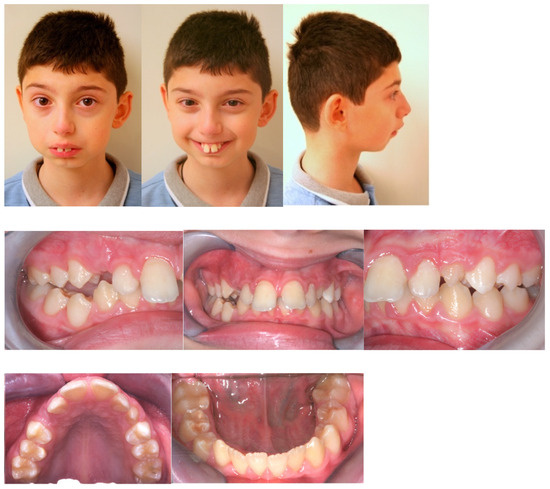
Figure 1.
Pre-treatment extra-oral and intra-oral photographs.
Intra-oral examination revealed that the patient had a Class II division 1 malocclusion with a 10.8 mm overjet and a traumatic overbite (Figure 1). The mandibular arch exhibited mild crowding, while the maxillary arch displayed mild spacing. The functional examination showed that the mandible deviated to the left when opening.
The panoramic radiograph showed the gap arthroplasty performed by the second author (SU) on the left TMJ (Figure 2). The second and third molars and upper right canine were all developing.
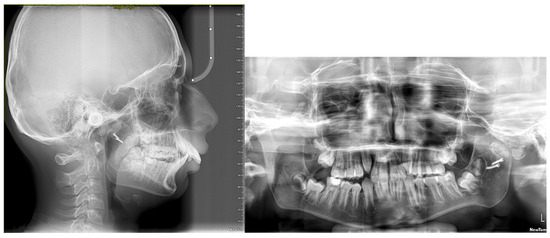
Figure 2.
Pre-treatment lateral cephalogram and panoramic radiograph.
The lateral cephalometric findings (Figure 2 and Table 1) confirmed a retrognathic mandible (SNB = 72.7°, Pogonion to McNamara Nasion Perpendicular = −11.6 mm), proclined maxillary incisors (U1-SN = 114.9°, U1-NA = 31.9°/7.0 mm), and a skeletal Class II malocclusion with an ANB of 10.3° and Wits of 15.8 mm. The patient had a hypodivergent skeletal pattern (SN-GoGn = 22.2°). The maxillary-mandibular planes angle was decreased (19.0°) and showed a short lower anterior face height. The soft tissue analysis revealed protrusive upper and lower lips with an obtuse nasolabial angle (Table 1).

Table 1.
Pre-treatment and post-treatment cephalometric analysis (SD = standard deviation).
3. Treatment Objectives
The objectives that would lead to an overall improvement in the profile and facial appearance were as follows:
- Improve the skeletal Class II by addressing the retrognathic mandible.
- Improve the convex facial profile.
- Establish lip competency.
- Improve upper incisor proclination.
- Close upper spacing.
- Relieve lower crowding.
- Level and align the teeth.
- Improve the occlusal cant.
- Improve the overjet.
- Improve the overbite.
- Improve molar and canine relationships.
- Monitor third molar development.
- Monitor the left TMJ.
- Retain final alignment and occlusion.
4. Treatment Alternatives
The following possible surgical treatment options could be explored for this patient:
- Bilateral sagittal split osteotomy
- Mandibular distraction osteogenesis
- Genioplasty
- Extractions and orthodontic camouflage
- Vertical ramus osteotomy [32,33].
The patient’s parents specifically asked for a treatment modality that did not involve OGS; therefore, all options above were eliminated with the exception of extractions and orthodontic camouflage. However, his parents were only willing to consider conservative treatment options involving orthodontics solely without extractions. The parents were advised that treatment could be undertaken without OGS, but the outcome would only camouflage the skeletal discrepancies in all three planes of space.
5. Treatment Progress
A 0.022 X 0.028-in DamonQ® (Ormco, Glendora, CA, USA) passive self-ligating pre-adjusted edgewise appliance was used (Figure 3). The maxillary arch was bonded to allow initial alignment, and the bonding of the mandibular arch was completed one month later. Upper incisors and canines were bonded with high torque brackets, and lower incisors and canines were bonded with low torque brackets. This was due to the requirement of employing Class II mechanics, which was expected to result in retroclination of the upper incisors and proclination of the lower incisors. As a result, placing high-torque brackets on the upper incisors and low-torque brackets on the lower incisors would help counteract these adverse effects [34,35]. Brackets were positioned more incisally in the upper anteriors to allow for relative intrusion.
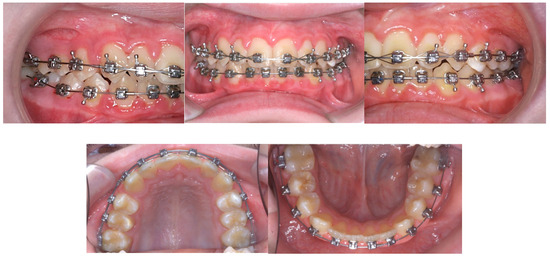
Figure 3.
Progress intra-oral photographs.
Initially, a 0.014-inch copper nickel–titanium (CuNiTi) archwire was used in the upper arch, and a 0.018-inch CuNiTi archwire was used in the lower arch to level and align the teeth. When the lower arch was bonded, bracket interferences required the placement of two bite turbos made from glass ionomer cement on the lower first molars. The maxillary archwire was changed to a 0.018-inch CuNiTi, and two composite bite turbos were applied to the palatal surfaces of the maxillary central incisors at month three. Early light short elastics (3/16″, 2 oz) were used from the upper first premolars to the lower first molars to protract the mandible and extrude the lower molars. Posterior bite turbos were removed as soon as the lower arch was aligned, at month five. At 11 months, upper and lower 0.014 X 0.025-inch CuNiTi archwires (Ormco, Glendora, CA, USA) were placed, followed by a 0.016 X 0.025-inch CuNiTi archwire. The light short elastics were replaced with conventional Class II elastics (¼″, 3.5 oz) from the upper canines to the lower first molars. A 0.018 X 0.025-inch CuNiTi archwire was subsequently used at month thirteen, and the upper anterior teeth were consolidated with a figure of eight steel ligature tie. The 0.019 X 0.025-inch stainless steel (SS) archwires were placed as the working archwires in both the upper and lower arches fifteen months after starting treatment. Fixed upper and lower lingual bonded retainers were placed at the end of active treatment, as the patient was approaching his fifteenth birthday.
Additionally, upper and lower vacuum retainers were used for retention. The patient was instructed to wear the removable retainers full-time for six months and then only at night. It was recommended that the third molars be monitored.
6. Treatment Results
The treatment aims were mainly achieved for this patient. The post-treatment frontal facial photographs showed a significant improvement in the patient’s facial esthetics (Figure 4). The intra-oral pictures revealed that the maxillary and mandibular arches were well aligned with Class I molar and canine relationships. The traumatic overbite and the large overjet were successfully corrected. In addition, the patient presented with an improved soft-tissue profile with a more prominent chin (Figure 4). A Class I canine, incisor, and molar relationship was attained on both sides following a treatment duration of 48 months. Treatment time was extended because of the disruption caused by the COVID-19 pandemic.
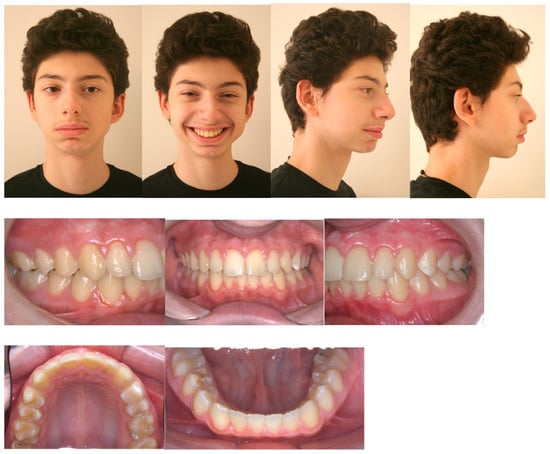
Figure 4.
Post-treatment extra-oral and intra-oral photographs.
Significant improvements were seen in the post-treatment lateral cephalometrics (Figure 5), particularly the Wits and Pogonion to McNamara Nasion Perpendicular (Table 1). The mandible was advanced whilst the maxilla was restrained, as shown in the superimposition of pre-treatment and post-treatment lateral cephalograms (Figure 6). Even though the skeletal Class II jaw base relationship remained, the lateral cephalometric analysis revealed a decrease in the ANB angle (8.8°). The maxillary incisors were retroclined from 121.9° to 114.5° (Table 1). The post treatment panoramic radiograph showed good root parallelism without any visible signs of root resorption (Figure 5).
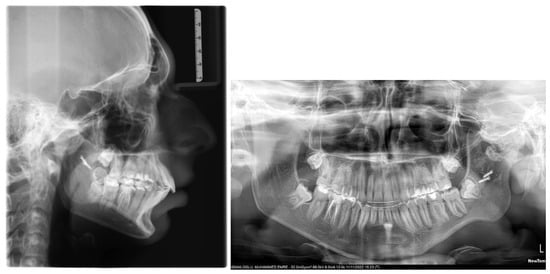
Figure 5.
Post-treatment lateral cephalogram and panoramic radiograph.
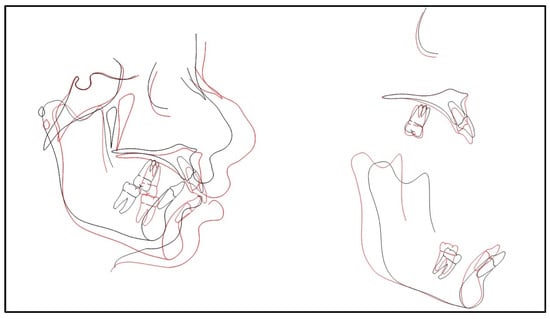
Figure 6.
Pre-treatment (black) and post-treatment (red) tracing superimposed on the anterior cranial base showing improved facial profile. The maxillary superimposition (superimposed on the best fit of the maxilla) and the mandibular superimposition (superimposed on Björk’s stable structures) are also shown.
No TMJ problems were observed on the left side during orthodontic treatment, despite prolonged use of Class II elastics. The patient exhibited an attractive smile and had more balanced facial proportions. He was satisfied with the significant improvement in dental alignment and functional occlusion, particularly in facial aesthetics, and he stated that this had given him a significant boost to his self-confidence (Figure 4).
At the 12-month post-treatment follow-up, the patient demonstrated a favorable outcome with no evident signs of relapse. A mouth opening of 32 mm was maintained, indicating a good range of motion, while mandibular asymmetry was not observed. The increased mobility and improved mandible function achieved during treatment were effectively preserved, reflecting the stability of the intervention outcomes within this period.
While the prognosis for long-term stability is generally good due to the expected control of the new maxillary incisor position by the lower lip, there is still a risk of recurrence of ankylosis, which could compromise the stability of dental occlusion. Long-term compliance with the retention regimen will be required to maintain intra-arch alignment.
7. Discussion
In this case, the post-treatment outcomes revealed significant improvements in facial esthetics, dental alignment, and occlusal relationships, aligning with the reported satisfaction levels with camouflage treatment comparable to surgical interventions [9]. These results reflect a broader trend where many young adults opt for non-surgical correction of Class II malocclusions. They embrace dental camouflage as a viable treatment option for concealing skeletal discrepancies and achieving satisfactory aesthetic and functional outcomes [5,36]. This shift in patient preference is supported by psychosocial research, which finds that many individuals are content with achieving the most significant possible improvement in dental function and aesthetics while placing less emphasis on facial change [37,38]. Furthermore, the long-term follow-up study by Mihalik et al. [4] reported comparable or even superior satisfaction levels with camouflage treatment compared to surgical interventions, contributing to the growing popularity of non-surgical orthodontic approaches among patients and practitioners. Moreover, orthodontic camouflage treatment offers benefits such as cost-effectiveness and reduced risk profile and trauma [3].
In the treatment of Class II malocclusion, the decision-making process for selecting treatment alternatives, such as non-extraction orthodontic camouflage using fixed appliances and early light short elastics, underscores the importance of patient-centered care. This involves considering individual patient characteristics, including the stage of development, the degree of malocclusion, and any existing conditions, as essential factors in determining the appropriate treatment method [39,40]. Emphasizing a non-surgical approach aligns with incorporating patient preferences into treatment planning, as noted by Phillips [41].This methodology is particularly relevant to our case, illustrating the critical role of integrating patient perspectives into the decision-making process for treatment options, thereby enhancing the effectiveness and suitability of the chosen orthodontic intervention.
In treating this patient, who was born prematurely with a history of septic arthritis and subsequent TMJ ankylosis, the challenges were manifold. The case highlights the efficacy of gap arthroplasty in managing TMJ ankylosis which can lead to significant functional and aesthetic impairments [42]. His condition, consistent with the findings in the literature on unilateral ankylosis leading to occlusal plane canting, necessitated a carefully tailored treatment approach. The patient’s successful treatment, characterized by improved facial asymmetry and mandibular alignment without surgical intervention, reflects the findings of Raposo et al. [40].
Given the patient’s history of septic arthritis, infection is identified as the probable cause in our case, in line with observations by Chidzonga [21]. The patient had experienced TMJ ankylosis since early childhood, leading to facial deformation and a significantly retrognathic mandible. This condition resulted in pronounced aesthetic concerns, adversely affecting the patient’s psychological and social well-being throughout his school years [39,43,44]. The treatment aimed to perform orthodontic corrections for facial aesthetics after gap arthroplasty on the left TMJ, supported by physical exercises to preserve mouth opening [26]. Fariña et al. [45] emphasize the importance of initiating early and continuing postoperative physiotherapy to minimize the likelihood of re-ankylosis post-TMJ gap arthroplasty. Gap arthroplasty, a surgical procedure involving the removal of the ankylosed segment of bone to create space between the ascending ramus and the temporal bone, is critical for restoring mandibular mobility and addressing the functional limitations caused by TMJ ankylosis [46]. This restoration of joint mobility is essential for enabling effective orthodontic interventions, facilitating proper tooth alignment and occlusal correction [47]. The interdependence between surgical management and orthodontic success is well-established, as functional restoration lays the foundation for subsequent orthodontic treatment.
Studies have explored the long-term outcomes of gap arthroplasty. Guruprasad et al. [48] reported significant improvements in mouth opening and functional restoration, which are prerequisites for successful orthodontic management. Additionally, gap arthroplasty has the potential to stimulate mandibular growth on the affected side, enhancing facial symmetry. Agarwal et al. [49] demonstrated that when combined with physiotherapy, the procedure resolves immediate functional impairments and promotes growth and balance, which is particularly important for children.
Post-operative management is crucial to maintaining the benefits of gap arthroplasty. Cho et al. [50] emphasized the importance of minimizing relapse through structured follow-up care, while Sandhu [51] highlighted that early orthodontic intervention during the mixed dentition phase can significantly influence dental and skeletal development. Timely orthodontic treatment stabilizes surgical outcomes and ensures more favorable long-term results, as Sinha [52] noted in the context of Class II malocclusions.
Comprehensive post-surgical strategies, including interdisciplinary collaboration, play a pivotal role in preventing recurrence and optimizing outcomes. Elgazzar et al. [27] underscored the importance of combining effective surgical and orthodontic management to achieve functional and esthetic success, aligning with the recommendations of Fivez et al. [53] on the value of coordinated care in complex cases. These findings collectively reinforce the necessity of a multidisciplinary approach to maximize the benefits of gap arthroplasty and ensure stable, long-term results.
Camouflage treatment of Class II division 1 malocclusions usually involves premolar extractions; however, orthodontic treatment with extractions remains controversial [53]. In the present case, the parents declined the surgical treatment option because of surgical complications and the risk of morbidity, while the camouflage orthodontic treatment was preferred. The patient was treated without extractions since premolar extractions are not indicated in deep bite patients with a horizontal growth pattern. This is because the extractions cause more damage to facial appearance by causing loss of vertical dimension, further retrusion of the already retrusive lower third of the face, and an increase in the nasolabial angle [54].
The results show an overall improvement in the facial appearance of the patient. Although a skeletal Class II pattern persisted following treatment, the patient’s facial outcome significantly improved. The prognosis for stability is good in this case as his treatment ended with Class I molar and canine relationships and good intercuspation; however, long-term compliance with the retention regimen will be required.
8. Conclusions
This case report highlights the successful management of severe skeletal Class II malocclusion in a child with TMJ ankylosis using a minimally invasive, patient-centered approach. Gap arthroplasty effectively restored mandibular mobility, providing the foundation for camouflage orthodontic treatment that improved facial esthetics, occlusion, and the patient’s overall confidence. By eliminating the need for OGS, this approach not only addressed functional and esthetic concerns but also alleviated the psychological distress caused by bullying. The outcomes underscore the importance of interdisciplinary collaboration in achieving comprehensive and transformative results for complex cases.
Author Contributions
Orthodontic treatment was provided by E.R.N. who also drafted the manuscript. S.U. undertook the surgical aspects of treatment. P.S. assisted with preparation and editing of the manuscript. All authors have read and agreed to the published version of the manuscript.
Funding
This research received no external funding.
Institutional Review Board Statement
No ethical approval was required because this is a case report and not an experimental or intervention study.
Informed Consent Statement
Written informed consent was obtained from the patient and patient’s parents to publish this report and the associated images.
Data Availability Statement
The data presented in this study are available on request from the corresponding author due to ethical reasons.
Conflicts of Interest
The authors declare no conflicts of interest.
References
- Papadopoulos, M.A. Non-compliance approaches for management of Class II malocclusion. In Skeletal Anchorage in Orthodontic Treatment of Class II Malocclusion; Papadopoulos, M.A., Ed.; Mosby: Maryland Heights, MO, USA, 2015; pp. 6–21. [Google Scholar] [CrossRef]
- Kaieda, A.K.; Lima, I.F.P.; Scanavini, M.A.; Coqueiro, R.S.; Pithon, M.M.; Rode, S.M.; Paranhos, L.R. Perception, knowledge and attitudes of Brazilian orthodontists on the treatment of Class II malocclusions. An. Acad. Bras. Cienc. 2017, 89, 2875–2885. [Google Scholar] [CrossRef] [PubMed]
- Zhou, Y.W.; Wang, Y.Y.; He, Z.F.; Lu, M.X.; Li, G.F.; Li, H. Orthodontic-surgical treatment for severe skeletal class II malocclusion with vertical maxillary excess and four premolars extraction: A case report. World J. Clin. Cases 2023, 11, 1106–1114. [Google Scholar] [CrossRef] [PubMed]
- Mihalik, C.A.; Proffit, W.R.; Phillips, C. Long-term follow-up of Class II adults treated with orthodontic camouflage: A comparison with orthognathic surgery outcomes. Am. J. Orthod. Dentofac. Orthop. 2003, 123, 266–278. [Google Scholar] [CrossRef] [PubMed]
- Naragond, A.; Kenganal, S.; Sagarkar, R.; Sugaradday. Orthodontic Camouflage Treatment in an Adult Patient with a Class II, Division 1 Malocclusion—A Case Report. J. Clin. Diagn. Res. 2013, 7, 395–400. [Google Scholar] [CrossRef]
- Demir, A.; Uysal, T.; Sari, Z.; Basciftci, F.A. Effects of camouflage treatment on dentofacial structures in Class II division 1 mandibular retrognathic patients. Eur. J. Orthod. 2005, 27, 524–531. [Google Scholar] [CrossRef]
- Upadhyay, M.; Yadav, S.; Nagaraj, K.; Uribe, F.; Nanda, R. Mini-implants vs fixed functional appliances for treatment of young adult Class II female patients: A prospective clinical trial. Angle Orthod. 2012, 82, 294–303. [Google Scholar] [CrossRef]
- Manik, P.K.; Kumar, M.; Yadav, A.; Dawar, M. Management of class II malocclusion in an adolescent patient with “The Poosh Appliance”: An in office fabricated fixed functional appliance. J. Indian Orthod. Soc. 2017, 51, 119–126. [Google Scholar] [CrossRef]
- Ruf, S.; Pancherz, H. Orthognathic surgery and dentofacial orthopedics in adult Class II Division 1 treatment: Mandibular sagittal split osteotomy versus Herbst appliance. Am. J. Orthod. Dentofac. Orthop. 2004, 126, 140–152. [Google Scholar] [CrossRef]
- Upadhyay, M.; Yadav, S.; Nagaraj, K.; Nanda, R. Dentoskeletal and soft tissue effects of mini-implants in Class II division 1 patients. Angle Orthod. 2009, 79, 240–247. [Google Scholar] [CrossRef]
- Bolio Casas, M.; Guzmán Valdivia, I. Orthodontic-surgical treatment of a class II division 1 patient. Case report. Rev. Mex. Orthod. 2017, 5, e240–e248. [Google Scholar] [CrossRef]
- Sundararajan, S.; Parameswaran, R.; Vijayalakshmi, D. Orthognathic Surgical Approach for Management of Skeletal Class II Vertical Malocclusion. Contemp. Clin. Dent. 2018, 9 (Suppl. 1), 173–176. [Google Scholar] [CrossRef] [PubMed]
- Zhang, N.; Bai, Y.; Li, S. Treatment of a Class II Division 1 malocclusion with miniscrew anchorage. Am. J. Orthod. Dentofac. Orthop. 2012, 141, e85–e93. [Google Scholar] [CrossRef] [PubMed]
- Lopatiene, K.; Dumbravaite, A. Relationship between tooth size discrepancies and malocclusion. Stomatologija 2009, 11, 119–124. [Google Scholar] [PubMed]
- Othman, S.A.; Harradine, N.W.T. Tooth-size discrepancy and Bolton’s ratios: A literature review. J. Orthod. 2006, 33, 45–51. [Google Scholar] [CrossRef]
- Othman, S.; Harradine, N. Tooth size discrepancies in an orthodontic population. Angle Orthod. 2007, 77, 668–674. [Google Scholar] [CrossRef]
- Aldrees, A.M.; Al-Shujaa, A.M.; Alqahtani, M.A.; Aljhani, A.S. Is arch form influenced by sagittal molar relationship or Bolton tooth-size discrepancy? BMC Oral Health 2015, 15, 70. [Google Scholar] [CrossRef]
- Alajlan, S.S.; Alsaleh, M.K.; Alshammari, A.F.; Alharbi, S.M.; Alshammari, A.K.; Alshammari, R.R. The prevalence of malocclusion and orthodontic treatment need of school children in Northern Saudi Arabia. J. Orthod. Sci. 2019, 8, 10. [Google Scholar] [CrossRef]
- Incorvati, C.; Gulotta, C.; Mirabile, F.M.C.; Badiali, G.; Marchetti, C. Current Trends in Skeletal Borderline Patients: Surgical versus Orthodontic Treatment Decisions—What Is the Evidence? Appl. Sci. 2022, 12, 4636. [Google Scholar] [CrossRef]
- Hunt, O.; Johnston, C.; Hepper, P.; Burden, D.; Stevenson, M. The influence of maxillary gingival exposure on dental attractiveness ratings. Eur. J. Orthod. 2002, 24, 199–204. [Google Scholar] [CrossRef]
- Chidzonga, M.M. Temporomandibular joint ankylosis: Review of thirty-two cases. Br. J. Oral Maxillofac. Surg. 1999, 37, 123–126. [Google Scholar] [CrossRef]
- Arakeri, G.; Kusanale, A.; Zaki, G.A.; Brennan, P.A. Pathogenesis of post-traumatic ankylosis of the temporomandibular joint: A critical review. Br. J. Oral Maxillofac. Surg. 2012, 50, 8–12. [Google Scholar] [CrossRef] [PubMed]
- el-Sheikh, M.M.; Medra, A.M. Management of unilateral temporomandibular ankylosis associated with facial asymmetry. J. Craniomaxillofac. Surg. 1997, 25, 109–115. [Google Scholar] [CrossRef] [PubMed]
- Das, U.M.; Keerthi, R.; Ashwin, D.P.; VenkataSubramanian, R.; Reddy, D.; Shiggaon, N. Ankylosis of temporomandibular joint in children. J. Indian Soc. Pedod. Prev. Dent. 2009, 27, 116–120. [Google Scholar] [CrossRef]
- Jung, S.Y.; Park, J.H.; Park, H.S.; Baik, H.S. Transport distraction osteogenesis combined with orthodontic treatment in a patient with unilateral temporomandibular joint ankylosis. Am. J. Orthod. Dentofac. Orthop. 2017, 151, 372–383. [Google Scholar] [CrossRef]
- Al-Rawee, R.Y.; Al-Khayat, A.M.S.; Saeed, S.S. True bony TMJ ankylosis in children: Case report. Int. J. Surg. Case Rep. 2019, 61, 67–72. [Google Scholar] [CrossRef]
- Elgazzar, R.F.; Abdelhady, A.I.; Saad, K.A.; Elshaal, M.A.; Hussain, M.M.; Abdelal, S.E.; Sadakah, A.A. Treatment modalities of TMJ ankylosis: Experience in Delta Nile, Egypt. Int. J. Oral Maxillofac. Surg. 2010, 39, 333–342. [Google Scholar] [CrossRef]
- de Paula-Júnior, D.F.; Santos, N.C.; da Silva, E.T.; Nunes, M.F.; Leles, C.R. Psychosocial impact of dental esthetics on quality of life in adolescents. Angle Orthod. 2009, 79, 1188–1193. [Google Scholar] [CrossRef]
- Jovanovic, J.; Lerner, R.M.; Lerner, J.V. Objective and subjective attractiveness and early adolescent adjustment. J. Adolesc. 1989, 12, 225–229. [Google Scholar] [CrossRef]
- Phillips, C.; Beal, K.N. Self-concept and the perception of facial appearance in children and adolescents seeking orthodontic treatment. Angle Orthod. 2009, 79, 12–16. [Google Scholar] [CrossRef]
- Clauser, L.; Curioni, C.; Spanio, S. The use of the temporalis muscle flap in facial and craniofacial reconstructive surgery. A review of 182 cases. J. Craniomaxillofac. Surg. 1995, 23, 203–214. [Google Scholar] [CrossRef]
- Gao, X.; Wang, T.; Song, J. Orthodontic and surgical management of a patient with severe skeletal Class II deformity and facial asymmetry: A case report with a 5-year follow-up. Am. J. Orthod. Dentofac. Orthop. 2017, 151, 779–792. [Google Scholar] [CrossRef] [PubMed]
- Sharma, P.; Kumar, S.; Singh, G.; Jain, S. Sequential treatment of unilateral temporo-mandibular joint ankylosis with distraction osteogenesis—A case report. Int. Orthod. 2020, 18, 584–592. [Google Scholar] [CrossRef] [PubMed]
- Damon, D. Damon System: The Workbook; Ormco: Orange, CA, USA, 2004. [Google Scholar]
- Thomas, W.W. Variable Torque for Optimal Inclination. Clin. Impress 2009, 17, 21–27. [Google Scholar]
- Sultana, N.; Hasan, M.N.; Hassan, G.S.; Naim, M.A.; Akther, N. Orthodontic camouflage management of a class II malocclusion with excessive overjet- A case report. Update Dent. Coll. J. 2014, 3, 41–45. [Google Scholar] [CrossRef]
- Thomas, P.M. Orthodontic camouflage versus orthognathic surgery in the treatment of mandibular deficiency. J. Oral Maxillofac. Surg. 1995, 53, 579–587. [Google Scholar] [CrossRef]
- Sicari, F.; Merlo, E.M.; Gentile, G.; Nucera, R.; Portelli, M.; Settineri, S.; Myles, L.A.M.; Militi, A. Body Image and Psychological Impact of Dental Appearance in Adolescents with Malocclusion: A Preliminary Exploratory Study. Children 2023, 10, 1691. [Google Scholar] [CrossRef]
- Kharbanda, O.P.; Chaurasia, S. Functional jaw orthopedics for Class II malocclusion: Where do we stand today? J. Indian Orthod. Soc. 2015, 49, 33–41. [Google Scholar] [CrossRef]
- Raposo, R.; Peleteiro, B.; Paço, M.; Pinho, T. Orthodontic camouflage versus orthodontic-orthognathic surgical treatment in class II malocclusion: A systematic review and meta-analysis. Int. J. Oral Maxillofac. Surg. 2018, 47, 445–455. [Google Scholar] [CrossRef]
- Phillips, C. Patient-centered outcomes in surgical and orthodontic treatment. Semin. Orthod. 1999, 5, 223–230. [Google Scholar] [CrossRef]
- Anantanarayanan, P.; Narayanan, V.; Manikandhan, R.; Kumar, D. Primary mandibular distraction for management of nocturnal desaturations secondary to temporomandibular joint (TMJ) ankylosis. Int. J. Pediatr. Otorhinolaryngol. 2008, 72, 385–389. [Google Scholar] [CrossRef]
- López, E.N.; Dogliotti, P.L. Treatment of temporomandibular joint ankylosis in children: Is it necessary to perform mandibular distraction simultaneously? J. Craniofac. Surg. 2004, 15, 879–885. [Google Scholar] [CrossRef] [PubMed]
- Resnick, C.M. Temporomandibular Joint Reconstruction in the Growing Child. Oral Maxillofac. Surg. Clin. N. Am. 2018, 30, 109–121. [Google Scholar] [CrossRef] [PubMed]
- Fariña, R.; Canto, L.; Gunckel, R.; Alister, J.P.; Uribe, F. Temporomandibular joint ankylosis: Algorithm of treatment. J. Craniofac. Surg. 2018, 29, 427–431. [Google Scholar] [CrossRef] [PubMed]
- Temerek, A.; Fahd, A. Conservative gap arthroplasty without interpositioning material for management of temporomandibular joint ankylosis in children: Clinical and Radiographic Outcomes in Upper Egypt. Egypt. Dent. J. 2019, 65, 143–148. [Google Scholar] [CrossRef]
- Passi, D.; Singh, G.; Singh, S.; Mehta, G.; Dutta, S.; Sharma, S. Advances in temporomandibular joint reconstruction in TMJ ankylosis: Our experiences and literature review. Int. J. Dent. Res. 2014, 2, 45–49. [Google Scholar] [CrossRef]
- Guruprasad, Y.; Chauhan, D.S.; Cariappa, K.M. A Retrospective Study of Temporalis Muscle and Fascia Flap in Treatment of TMJ Ankylosis. J. Maxillofac. Oral Surg. 2010, 9, 363–368. [Google Scholar] [CrossRef]
- Agarwal, A.; Ruparelia, B.; Kubawat, A.; Patel, S.; Gupta, S. Modified gap arthroplasty and Myrhaug’s incision as a treatment option in management of temporomandibular joint ankylosis: A study of 10 cases. J. Contemp. Dent. Pract. 2011, 12, 295–300. [Google Scholar] [CrossRef]
- Cho, J.-W.; Park, J.-H.; Kim, J.-W.; Kim, S.-J. The sequential management of recurrent temporomandibular joint ankylosis in a growing child: A case report. Maxillofac. Plast. Reconstr. Surg. 2016, 38, 39. [Google Scholar] [CrossRef]
- Sandhu, A.; Sakaria, B.A.; Patel, S.D.; Ahuja, G.; Jadeja, N.; Mehta, A.; Kakkad, D. The Impact of Early Orthodontic Intervention on Dental and Skeletal Development in Children with Mixed Dentition. J. Pharm. Bioallied. Sci. 2024, 16 (Suppl. 1), S818–S820. [Google Scholar] [CrossRef]
- Sinha, A.; Subashree, S.; Avirachan, T.V.; Imran, M.; Chidambaram, D.; Prasad, S.M.V. Effect of Early Orthodontic Treatment on Long-Term Stability of Class II Malocclusions. J. Pharm. Bioallied. Sci. 2024, 16 (Suppl. 2), S1808–S1810. [Google Scholar] [CrossRef]
- Fivez, S.; Politis, C.; Dormaar, J.T.; Cadenas de Llano-Pérula, M. Surgical and Orthodontic Approach to Temporomandibular Joint Ankylosis After Ear Infection: A Case Series. J. Oral Maxillofac. Surg. 2020, 78, 2235–2246. [Google Scholar] [CrossRef]
- Quinzi, V.; Paskay, L.C.; D’andrea, N.; Albani, A.; Monaco, A.; Saccomanno, S. Evaluation of the Nasolabial Angle in Orthodontic Diagnosis: A Systematic Review. Appl. Sci. 2021, 11, 2531. [Google Scholar] [CrossRef]
Disclaimer/Publisher’s Note: The statements, opinions and data contained in all publications are solely those of the individual author(s) and contributor(s) and not of MDPI and/or the editor(s). MDPI and/or the editor(s) disclaim responsibility for any injury to people or property resulting from any ideas, methods, instructions or products referred to in the content. |
© 2025 by the authors. Licensee MDPI, Basel, Switzerland. This article is an open access article distributed under the terms and conditions of the Creative Commons Attribution (CC BY) license (https://creativecommons.org/licenses/by/4.0/).